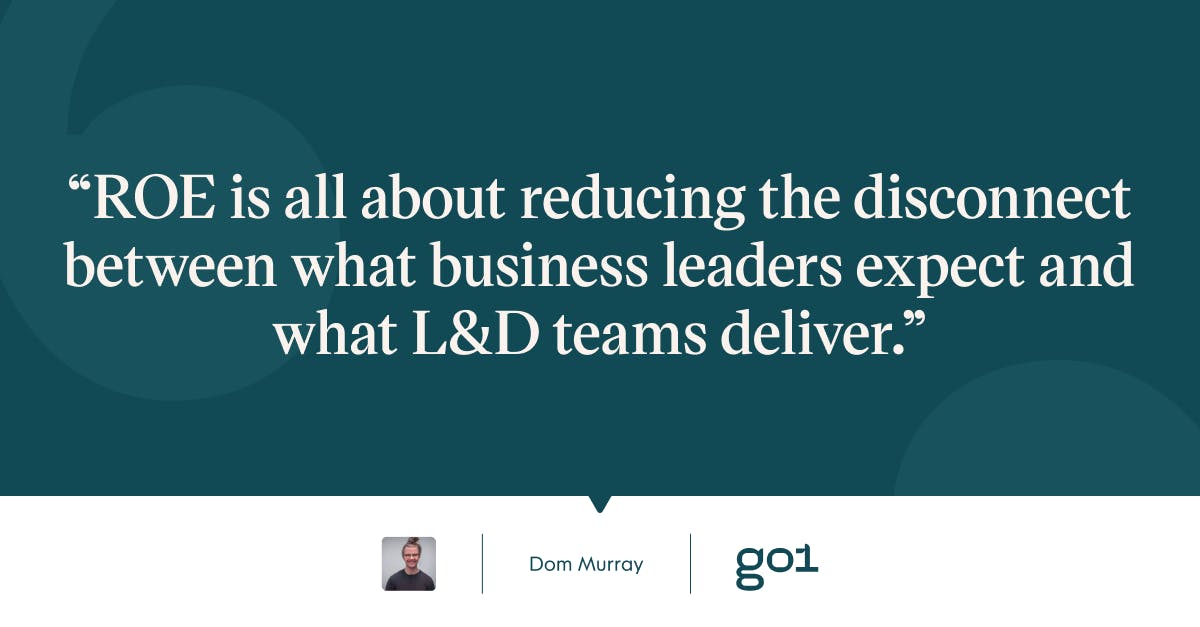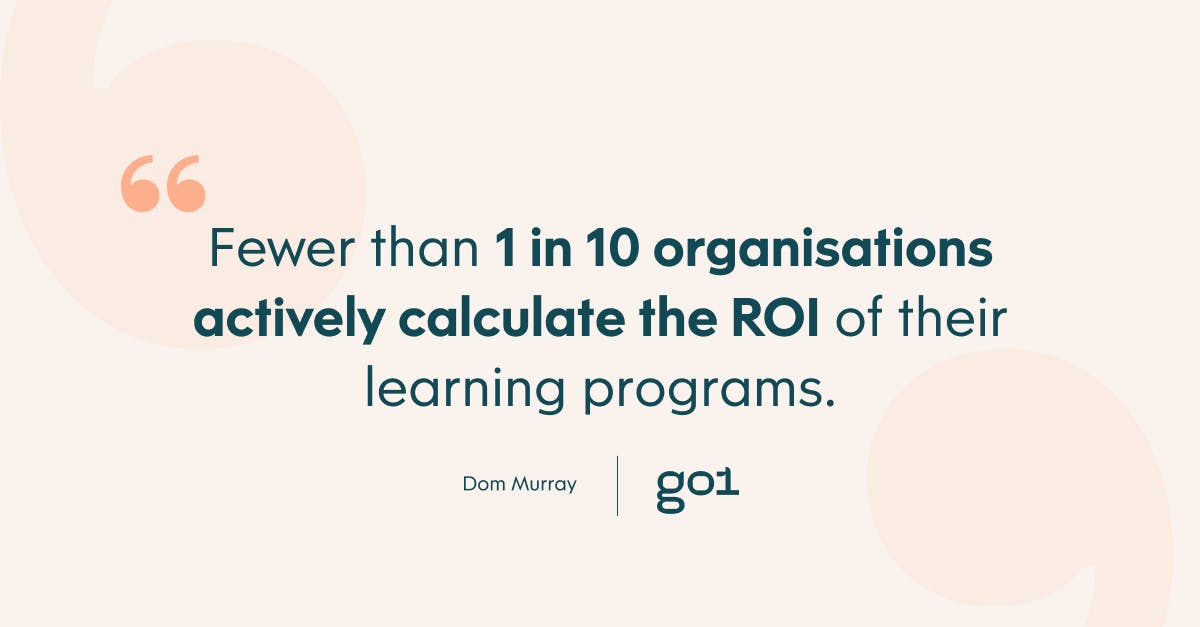
Should L&D teams be measuring ROE more than ROI?

For L&D teams, proving business value has often been a tricky proposition. You know the work you do is valuable. Your learners know the work you do is valuable. However, measuring and reporting on that value is often a different story. While the work that L&D teams do is critical, it can often be subjective and difficult to quantify in terms that business executives respond to, leading to significant disconnects between L&D teams and the rest of the organisation.
One potential reason for these disconnects is that L&D teams have been taking the wrong approach to measuring business value. As learning technologies become more sophisticated and empowering learners becomes increasingly essential, many experts argue that L&D teams should focus less on measuring return on investment (ROI) and more on measuring return on expectation (ROE).
We’ll dig deeper into this debate by asking if L&D teams should measure ROE more than ROI. We’ll start by explaining the terms ROE and ROI in an L&D context, before moving on to the advantages of measuring ROE over ROI for L&D teams.
What is ROE for L&D teams?
In an L&D context, ROE stands for return on expectations. Return on expectations should not be confused with the other common meaning of ROE, return on equity.
According to Learning Pool, “defining return-on-expectation is a process where learning professionals ask questions to clarify and refine the expectations of the key business stakeholders, so that they are satisfying these expectations whilst realistically achieving results in training. It’s about converting often generic expectations into observable, measurable success outcomes that the overall business values.”
Similarly, Training Zone explains that ROE is valuable by “ensuring that training objectives are strategically relevant to the organisation in the first place, clearly defining the expectations of the outcomes of the training, and then evaluating against both the training objectives and the agreed expectations.”
Therefore, ROE is all about reducing the disconnect between what business leaders expect and what L&D teams deliver, thereby increasing the strategic relevance of L&D teams’ key deliverables. ROE means taking a more comprehensive approach to measuring L&D’s impact by aligning programme evaluation with organisational goals. As LinkedIn explains, measuring ROE “allows us to move away from a purely financial lens and instead evaluate a programme’s success more holistically.”

Largely, the idea of ROE centres around the Kirkpatrick Model. First coined in the late 1950s by Dr Donald Kirkpatrick, the Kirkpatrick model is used in L&D circles worldwide to analyse ROE and measure the effectiveness of training programs.
While the model has undergone some minor tweaks over the years, the basic four-step program remains the cornerstone of measuring ROE for L&D teams. These are:
1. Reaction: Measure learners’ reaction to the training material to gain insights into the quality of the learning material and whether it is the right fit for a specific learner. Ask yourself, did learners enjoy the training? To what degree did learners apply themselves to the material?
2. Learning: Next, you need to measure how much information learners absorbed and retained so you can evaluate this against individual learning objectives. Ask yourself, did learning transfer occur successfully? Did participants gain the intended knowledge and skills from the training materials?
3. Behaviour: This level is all about measuring the impact of your training. In other words, has the training actually influenced learner behaviour? Ask yourself, are learners applying the information they learned on the job?
4. Results: Finally, you can measure the broader impact of your training. By this stage, you should have a firm grasp of the ROE of your training program. Ask yourself, did the training improve learner performance and achieve the desired organisational outcomes? If not, what lessons can I take to improve next time?
While there are many advantages to following the Kirkpatrick Model of ROE (more on these later), Training Check summarises the key benefits, explaining, “by progressing through each of the levels, training evaluators can build a ‘chain of evidence’ which links learning directly with organisational performance.”
For example, by ensuring learners are responsive to the training in step one, you can ensure they take information onboard in step two, which feeds into behaviour change and tangible results in steps three and four.
By managing expectations every step of the way, you will gain a clearer picture of what your learning program achieved and be able to clearly communicate these outcomes to executives.
What is ROI for L&D teams?
In contrast to ROE, ROI is likely an evaluation model you are already familiar with. ROI stands for return on investment and is one of the most common metrics businesses use to measure success.
As Investopedia puts it, “return on investment (ROI) is a performance measure used to evaluate the efficiency or profitability of an investment or compare the efficiency of a number of different investments. ROI tries to directly measure the amount of return on a particular investment, relative to the investment’s cost. To calculate ROI, the benefit (or return) of an investment is divided by the cost of the investment. The result is expressed as a percentage or a ratio.”
Nevertheless, many industry leaders posit that it is time for L&D teams to move on from ROI and look toward other metrics. In a recent article, Reworked proposed that ROI is a “dead metric” for L&D teams. Similarly, People Management put forward that calculating ROI for L&D is “like finding a needle in a haystack.” Others have expressed similar sentiments, as many L&D leaders are all too familiar with the challenges of attempting to quantify their work via ROI.
With this in mind, now might be the perfect time to transition from ROI to the greener pastures of ROE.
For more insights into measuring ROI for L&D teams, check out our article on Improving ROI metrics to showcase L&D’s value.
The advantages of measuring ROE over ROI for L&D
There are significant advantages to measuring ROE over ROI for L&D teams. One of the best arguments for transitioning from ROI to ROE is that many L&D teams already struggle to prove ROI.
For example, Emerald Works’ 2020 Back to the Future Report found that while 98% of L&D teams think ‘program evaluation’ is a priority, only 38% currently have this capability. Worse, this is trending in the wrong direction, down from 45% of teams in 2018.
Additionally, Emerald Works’ Report finds that just 8% of L&D teams calculate return on investment for their learning programs. That’s right, fewer than 1 in 10 organisations actively calculate the ROI of their learning programs.

Likewise, Chief Learning Officer Magazine’s 2020 State of Learning Report ranked ROI last (24.2%) when L&D leaders were asked which metrics they use to determine the impact of leadership development programs. Employee engagement (48.8%) and retention/attrition of top performers (48.6%) finished first and second, respectively.
ROI also finished last when L&D leaders were asked about the metrics they report to executives to demonstrate the impact of training programs. In that category, “general training output data” came out on top. As such, it seems that ROI is becoming less and less valuable for L&D teams to measure.
So, if ROI is on the wane as an L&D metric, what advantages does measuring ROE present?
In their own words, the Kirkpatricks describe ROE as “the ultimate indicator of value. It is a holistic measurement of all of the benefits (both qualitative and quantitative) realised from a program or initiative brought about through a package of interventions.”
Accordingly, ROE is all about setting and managing clear expectations for the outcomes of learning programs. By measuring ROE, you can increase stakeholder buy-in, as everyone is on the same page about what your learning program aims to achieve.
As Learning Pool puts it, measuring ROI “means the results you achieve are directly correlated with the results your stakeholders are expecting. And, by defining these goals early on you are able to benchmark better and more clearly understand the true business impact of your training, way beyond just the cost savings.”
Similarly, LinkedIn provides a concrete example of when ROE comes in handy over ROI, using the example of a leadership training program. They explain, “instead of painstakingly drilling down how each module provides financial return, L&D professionals can select metrics that will directly measure their expected outcomes, such as how motivated leaders feel before and after a programme or the direct application of learning content back at work.”
Put simply, ROE is all about setting clear goals from the outset of an L&D initiative. By managing expectations and ensuring all key stakeholders are on the same page, you can then measure the success of an initiative against these expectations, thereby solving the age-old dilemma of quantifying L&D’s business value.
In other words, by switching to ROE, you will be reporting on more relevant and measurable metrics, which are agreed upon collaboratively beforehand. Instead of looking at the financial returns of a single training module, you can take a more holistic approach and analyse how that training impacted learner behaviour and what effect that has on broader business outcomes.

Therefore, by focussing less on ROI and more on ROE, L&D leaders can spend more time worrying about whether learners are actually learning. This is perhaps the greatest advantage of measuring ROE over ROI. After all, a love of learning should be at the heart of any successful training program.
For more insights, be sure to subscribe to the Go1 newsletter to stay on top of all the latest L&D trends. Or, you can book a demo today to find out how Go1 can help with your team’s learning needs.




